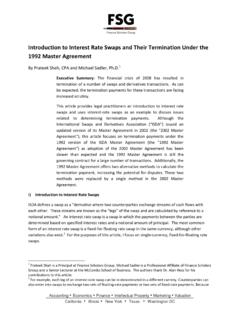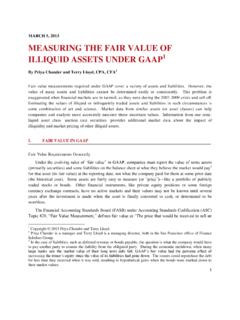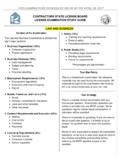Transcription of The Use of Choice-Based Conjoint Analysis and …
1 1 The Use of Choice-Based Conjoint Analysis and willingness to Pay in Patent Damages Mark Glueck Tim Savage Presented to: Winston & Strawn Date: November 29, 2012 Location: Washington, DC 2 Overview What is Choice-Based Conjoint ( CBC ) Analysis and what patent damage issues does it seek to answer? What is willingness to pay ( WTP )? CBC, WTP and the calculation of IP damages (within the context of Georgia Pacific) Admissibility/Daubert considerations Application of CBC and WTP in Apple v. Samsung What s ahead? 3 How Did We Get Here? Entire market value rule applicable only when the patented feature is basis for consumer demand - Lucent v.
2 Gateway. Cornell v. HP, IP Innovation v. Red Hat Judge Rader criticizes failure to link consumer demand to the claimed invention. (GP #8, #11, #13) Infirmities with apportionment and attribution methods (royalty rate v. royalty base). Contemporaneous business documents are rarely a useful guide in isolating the value of individual features as they pertain to use of the technology at issue Task: How to value features/technology when no independent market exists (no sales with and without the patented feature) 4 Conjoint Analysis A credit card could offer a multitude of features that consumers value acceptance, rebates, insurance, related services, etc.
3 Consumers want the most features at the lowest price. From the perspective of the producer, however, this may not be true given production costs. There are no neutral control features , so demand must be measured relative to other attributes consumers likely prefer. Therefore, there are trade-offs between price and features that producers don t know before product launch. Conjoint Analysis permits a realistic evaluation of choices among hypothetical features that vary simultaneously: Conjoint = consider jointly . The predominant form of this is so-called Choice-Based Conjoint Analysis ( CBC ), where products are considered to be different combinations of features and price.
4 5 Conjoint Analysis Grounded in Empirical Marketing Conjoint Analysis has long been used in product design and pricing: -Heublein distilled spirits -AT&T in cell phone features -IBM RISC 6000 Workstation features -UPS study of features among overnight letter carriers -MasterCard travel and entertainment features -FedEx design of tracking system -Marriott time-share units -Ritz Carlton rooms -Packaging of Monsanto herbicides -AARP health maintenance plans -EZ Pass 6 Use of Conjoint in Non-Patent Cases U-Haul v. Jartan (Lanham Act) Continental Airlines v. American Airlines (Contract) Barbara Schwab et al v.
5 Philip Morris (RICO/False Claims) v. Dentsply (Antitrust) Aspen Highlands Skiing v. Aspen Skiing Co. (Antitrust) 7 Illustrative Features of a Golf Ball Average Driving Distance Average Ball Life Price 225 yards 50 holes $ 250 yards 30 holes $ 275 yards 20 holes $ Consumer's Ideal Ball 275 yards 50 holes $ Producer's Ideal Ball 225 yards 20 holes $ 8 Consumers and Producers From a consumer s point of view, the ideal ball would be the one with the longest average driving distance, the longest average ball life, and the lowest price. From a producer s view, an ideal ball would be the highest price, perhaps with the shortest average distance and life (assuming it costs less to produce such a ball).
6 Therefore, from a marketing perspective, the most viable option is a product lies somewhere in between. But the producer does not know where. This is the role of CBC. In this example, it would examine consumer preferences and trade offs between life, distance, and price jointly. 9 Elements of CBC Analysis Pre-testing and survey design (how many attributes to be tested six considered to be the outer bound). Survey execution (can be conducted online). Processing and Analysis of survey results. Use of results to determine partworths . Testing for economic logic of partworths (what, if anything, went wrong in the black box ).
7 Input to royalty rate measure. 10 CBC Surveys CBC is implemented using a survey where participants are a random sample of a target population (experience with the product). Respondents are presented with a series of questions that examine price/attribute trade offs In the golf ball example, each respondent would be asked to rank driving distance against ball life and ball life against price. Some respondents may have strong preferences for distances, and others for life. Typically, survey size is about 500 respondents. More recent surveys used in litigation have used sophisticated statistical techniques to analyze the dispersion of responses.
8 11 Two Hypothetical Respondents Respondent 1 (Weak Preference for Distance) Life 50 holes 30 holes 20 holes 225 yards 7 8 9 Distance 250 yards 3 5 6 275 yards 1 2 4 Respondent 2 (Weak Preference for Life) Life 50 holes 30 holes 20 holes 225 yards 4 7 9 Distance 250 yards 2 5 8 275 yards 1 3 6 12 Ranks Are Translated Values are assigned to the attributes, which is somewhat arbitrary. Key: better attributes should be given higher values. Respondent 1 (Weak Preference for Distance) Life 50 holes 30 holes 20 holes 225 yards 7 (50) 8 (25) 9 (0) Distance 250 yards 3 (110) 5 (85) 6 (60) 275 yards 1 (150) 2 (125) 4 (100) 13 Trade Off Between Life and Price Respondent 1 Ranks Price $ $ $ 50 holes 1 2 3 Life 30 holes 4 5 6 20 holes 7 8 9 Respondent 1 Values Price $ $ $ 225 yards 70 55 50 Distance 250 yards 45 30 25 275 yards 20 5 0 14 Given the Conjoint Trade Offs We obtain a complete set of values, which are called utilities or partworths or partworth utility.
9 Utility is simply economics for implicit value: individuals choose an outcome among option that brings them the highest utility. Below are the partworths associated with attributes. Average Driving Distance Average Ball Life Price 225 yards 0 50 holes 50 $ 20 250 yards 60 30 holes 25 $ 5 275 yards 100 20 holes 0 $ 0 15 Comparison of Hypothetical Golf Balls The results allow us to compare the total utility a respondent would achieve given two hypothetical configurations. Long-Distance Ball Long-Life Ball Distance 275 yards 250 yards Life 20 holes 50 holes Price $ $ 16 Presented with the Alternatives Choose the golf ball that yields highest utility: long life.
10 Long-Distance Ball Long-Life Ball Attribute Partworth Attribute Partworth Distance 275 yards 100 250 yards 60 Life 20 holes 0 50 holes 50 Price $ 5 $ 0 105 110 17 Feature willingness -to-Pay (WTP) WTP for features can be estimated using the partworth utilities, from which a royalty rate can be derived Step 1: Hypothetical Price Change: $ $ = $ Change in Utility : 20 5 = 15 Implied dollars per util : $.25 / 15 = $.017 Step 2: Utility Gain from Feature: * 50 utils minus 25 utils = 25 utils willingness -to-Pay: 25 utils X $.










